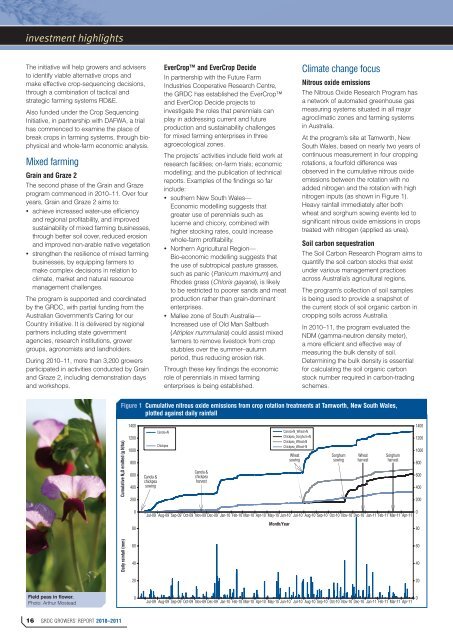grdc growers' report - Grains Research & Development Corporation
grdc growers' report - Grains Research & Development Corporation
grdc growers' report - Grains Research & Development Corporation
Create successful ePaper yourself
Turn your PDF publications into a flip-book with our unique Google optimized e-Paper software.
investment highlights<br />
The initiative will help growers and advisers<br />
to identify viable alternative crops and<br />
make effective crop-sequencing decisions,<br />
through a combination of tactical and<br />
strategic farming systems RD&E.<br />
Also funded under the Crop Sequencing<br />
Initiative, in partnership with DAFWA, a trial<br />
has commenced to examine the place of<br />
break crops in farming systems, through biophysical<br />
and whole-farm economic analysis.<br />
Mixed farming<br />
Grain and Graze 2<br />
The second phase of the Grain and Graze<br />
program commenced in 2010–11. Over four<br />
years, Grain and Graze 2 aims to:<br />
• achieve increased water-use efficiency<br />
and regional profitability, and improved<br />
sustainability of mixed farming businesses,<br />
through better soil cover, reduced erosion<br />
and improved non-arable native vegetation<br />
• strengthen the resilience of mixed farming<br />
businesses, by equipping farmers to<br />
make complex decisions in relation to<br />
climate, market and natural resource<br />
management challenges.<br />
The program is supported and coordinated<br />
by the GRDC, with partial funding from the<br />
Australian Government’s Caring for our<br />
Country initiative. It is delivered by regional<br />
partners including state government<br />
agencies, research institutions, grower<br />
groups, agronomists and landholders.<br />
During 2010–11, more than 3,200 growers<br />
participated in activities conducted by Grain<br />
and Graze 2, including demonstration days<br />
and workshops.<br />
EverCrop and EverCrop Decide<br />
In partnership with the Future Farm<br />
Industries Cooperative <strong>Research</strong> Centre,<br />
the GRDC has established the EverCrop<br />
and EverCrop Decide projects to<br />
investigate the roles that perennials can<br />
play in addressing current and future<br />
production and sustainability challenges<br />
for mixed farming enterprises in three<br />
agroecological zones.<br />
The projects’ activities include field work at<br />
research facilities; on-farm trials; economic<br />
modelling; and the publication of technical<br />
<strong>report</strong>s. Examples of the findings so far<br />
include:<br />
• southern New South Wales—<br />
Economic modelling suggests that<br />
greater use of perennials such as<br />
lucerne and chicory, combined with<br />
higher stocking rates, could increase<br />
whole-farm profitability.<br />
• Northern Agricultural Region—<br />
Bio-economic modelling suggests that<br />
the use of subtropical pasture grasses,<br />
such as panic (Panicum maximum) and<br />
Rhodes grass (Chloris gayana), is likely<br />
to be restricted to poorer sands and meat<br />
production rather than grain-dominant<br />
enterprises.<br />
• Mallee zone of South Australia—<br />
Increased use of Old Man Saltbush<br />
(Atriplex nummularia) could assist mixed<br />
farmers to remove livestock from crop<br />
stubbles over the summer–autumn<br />
period, thus reducing erosion risk.<br />
Through these key findings the economic<br />
role of perennials in mixed farming<br />
enterprises is being established.<br />
Climate change focus<br />
Nitrous oxide emissions<br />
The Nitrous Oxide <strong>Research</strong> Program has<br />
a network of automated greenhouse gas<br />
measuring systems situated in all major<br />
agroclimatic zones and farming systems<br />
in Australia.<br />
At the program’s site at Tamworth, New<br />
South Wales, based on nearly two years of<br />
continuous measurement in four cropping<br />
rotations, a fourfold difference was<br />
observed in the cumulative nitrous oxide<br />
emissions between the rotation with no<br />
added nitrogen and the rotation with high<br />
nitrogen inputs (as shown in Figure 1).<br />
Heavy rainfall immediately after both<br />
wheat and sorghum sowing events led to<br />
significant nitrous oxide emissions in crops<br />
treated with nitrogen (applied as urea).<br />
Soil carbon sequestration<br />
The Soil Carbon <strong>Research</strong> Program aims to<br />
quantify the soil carbon stocks that exist<br />
under various management practices<br />
across Australia’s agricultural regions.<br />
The program’s collection of soil samples<br />
is being used to provide a snapshot of<br />
the current stock of soil organic carbon in<br />
cropping soils across Australia.<br />
In 2010–11, the program evaluated the<br />
NDM (gamma-neutron density meter),<br />
a more efficient and effective way of<br />
measuring the bulk density of soil.<br />
Determining the bulk density is essential<br />
for calculating the soil organic carbon<br />
stock number required in carbon-trading<br />
schemes.<br />
Figure 1 Cumulative nitrous oxide emissions from crop rotation treatments at Tamworth, New South Wales,<br />
plotted against daily rainfall<br />
Daily rainfall (mm) Cumulative N 2 O emitted (g N/ha)<br />
1400<br />
1200<br />
1000<br />
800<br />
600<br />
400<br />
200<br />
0<br />
80<br />
60<br />
40<br />
Canola &<br />
chickpea<br />
sowing<br />
Canola+N<br />
Chickpea<br />
Canola &<br />
chickpea<br />
harvest<br />
Month/Year<br />
Canola+N_Wheat+N<br />
Chickpea_Sorghum+N<br />
Chickpea_Wheat+N<br />
Chickpea_Wheat–N<br />
Wheat<br />
sowing<br />
Sorghum<br />
sowing<br />
Wheat<br />
harvest<br />
Sorghum<br />
harvest<br />
Jul-09 Aug-09 Sep-09 Oct-09 Nov-09 Dec-09 Jan-10 Feb-10 Mar-10 Apr-10 May-10 Jun-10 Jul-10 Aug-10 Sep-10 Oct-10 Nov-10 Dec-10 Jan-11 Feb-11 Mar-11 Apr-11<br />
1400<br />
1200<br />
1000<br />
800<br />
600<br />
400<br />
200<br />
0<br />
80<br />
60<br />
40<br />
20<br />
20<br />
Field peas in flower.<br />
Photo: Arthur Mostead<br />
0<br />
Jul-09 Aug-09 Sep-09 Oct-09 Nov-09 Dec-09 Jan-10 Feb-10 Mar-10 Apr-10 May-10 Jun-10 Jul-10 Aug-10 Sep-10 Oct-10 Nov-10 Dec-10 Jan-11 Feb-11 Mar-11 Apr-11<br />
0<br />
16 GRDC GROWERS’ REPORT 2010–2011

















